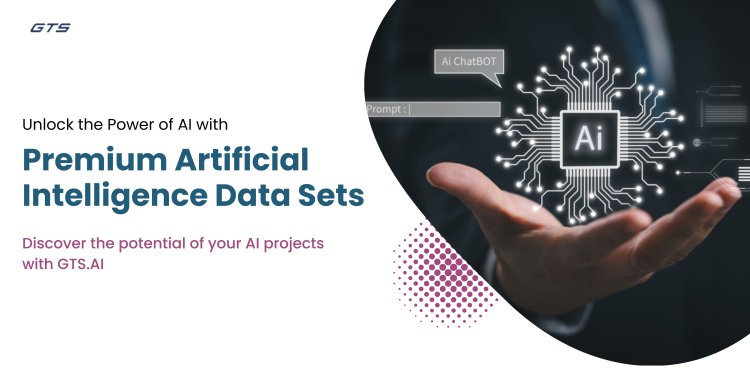Exploring AI Datasets: The Foundation of Intelligent Systems
AI data sets for machine learning
Share this Post to earn Money ( Upto ₹100 per 1000 Views )
Artificial intelligence (AI) has revolutionized how we solve problems, from automating routine tasks to powering innovations in healthcare, finance, and entertainment. However, at the heart of AI’s capabilities lies an often-overlooked component datasets. Artificial intelligence data sets serve as the foundational building blocks that enable machines to learn, reason, and make decisions. This blog explores what AI datasets are, their significance, types, challenges, and their role in shaping the future of AI.
What Are AI Datasets?
AI datasets are collections of structured or unstructured data used to train, validate, and test AI models. These datasets consist of information in various formats, including text, images, videos, audio, and numerical data. For example, a dataset for natural language processing (NLP) may include thousands of sentences labeled with their grammatical structure. In contrast, a dataset for computer vision might feature annotated images of objects, people, or scenes.
Why Are AI Datasets Important?
-
Training AI Models
Machine learning-based AI models depend on datasets to understand patterns and establish relationships. The effectiveness of these models is significantly impacted by the quality and amount of data they are trained on. -
Boosting Accuracy
A well-constructed dataset allows models to adapt effectively to new, unseen scenarios, reducing errors and improving their performance in practical applications. -
Evaluation and Benchmarking
Using standardized datasets helps assess and compare the capabilities of various AI models, driving progress and innovation across the industry. -
Fostering Innovation
Access to high-quality datasets enables researchers to experiment with cutting-edge algorithms and techniques, paving the way for groundbreaking advancements in AI.
Types of AI Datasets
AI datasets can be classified based on their format and purpose.
-
Text Datasets
-
Examples: Wikipedia, OpenSubtitles, and Common Crawl.
-
Uses: NLP tasks such as sentiment analysis, machine translation, and text summarization.
-
Image Datasets
-
Examples: ImageNet, COCO (Common Objects in Context), and MNIST (handwritten digits).
-
Uses: Tasks like object detection, image classification, and facial recognition.
-
Audio Datasets
-
Examples: LibriSpeech, UrbanSound8K, and VoxCeleb.
-
Uses: Speech recognition, sound classification, and voice synthesis.
-
Video Datasets
-
Examples are Kinetics, UCF101, and AVA (Atomic Visual Actions).
-
Uses: Action recognition, video summarization, and video segmentation.
-
Tabular Datasets
-
Example: UCI Machine Learning Repository, Kaggle datasets.
-
Uses: Predictive modeling, recommendation systems, and fraud detection.
-
Specialized Datasets
-
Datasets tailored for specific industries, such as medical imaging datasets for healthcare or financial datasets for economic forecasting.
Challenges in Creating AI Datasets
-
Data Quality
Poor-quality data, such as incomplete or mislabeled entries, can hinder model performance. Ensuring clean and consistent data requires significant effort. -
Bias and Fairness
If datasets are unbalanced or contain biases, AI models trained on them may exhibit discriminatory behavior. For instance, a facial recognition model trained predominantly on images of one demographic may struggle with accuracy for others. -
Privacy Concerns
Using personal or sensitive data in AI projects raises ethical and legal questions. Developers must ensure data is anonymized and comply with regulations like GDPR. -
Scalability
As AI models grow more complex, they require increasingly large datasets. Collecting, storing, and managing such volumes of data can be challenging. -
Annotation and Labeling
High-quality datasets often require human-annotated labels, which can be time-consuming and costly.
Popular AI Datasets
-
ImageNet
A benchmark dataset for image classification and object detection tasks, featuring over 14 million labeled images. -
COCO (Common Objects in Context)
A rich dataset with annotated images for object detection, segmentation, and captioning tasks. -
OpenAI’s GPT-3 Training Dataset
A massive text dataset compiled from books, websites, and other sources to train large language models. -
KITTI
A dataset used for training autonomous vehicles, including images, 3D point clouds, and GPS data. -
SQuAD (Stanford Question Answering Dataset)
Designed for NLP tasks, it consists of questions and answers linked to specific paragraphs of text.
The Role of Open Data in AI
Open datasets play a critical role in democratizing AI. Platforms like Kaggle, Data.gov, and Open Data Portal provide free access to datasets, empowering researchers and developers worldwide to experiment and innovate. Open datasets also promote transparency and reproducibility in AI research.
The Future of AI Datasets
As AI continues to evolve, the demand for diverse, high-quality datasets will grow. Emerging trends in the field include:
-
Synthetic Data Generation
Advances in generative models allow the creation of synthetic datasets, which can supplement real-world data and address gaps in representation. -
Federated Learning
This approach enables AI models to learn from decentralized datasets without sharing raw data, enhancing privacy. -
Real-Time Data Annotation
AI-powered tools are making it faster and cheaper to annotate large datasets. -
Domain-Specific Datasets
Future datasets will likely cater to niche industries and specialized tasks, enhancing the adaptability of AI models.
Conclusion

AI datasets are the cornerstone of intelligent systems, providing the information models needed to learn and perform effectively. While challenges such as data quality, bias, and scalability persist, innovations in synthetic data generation and annotation methods are paving the way for more robust and ethical AI applications. Whether you’re a researcher, developer, or enthusiast, understanding and leveraging the right datasets is key to unlocking the full potential of AI.
















